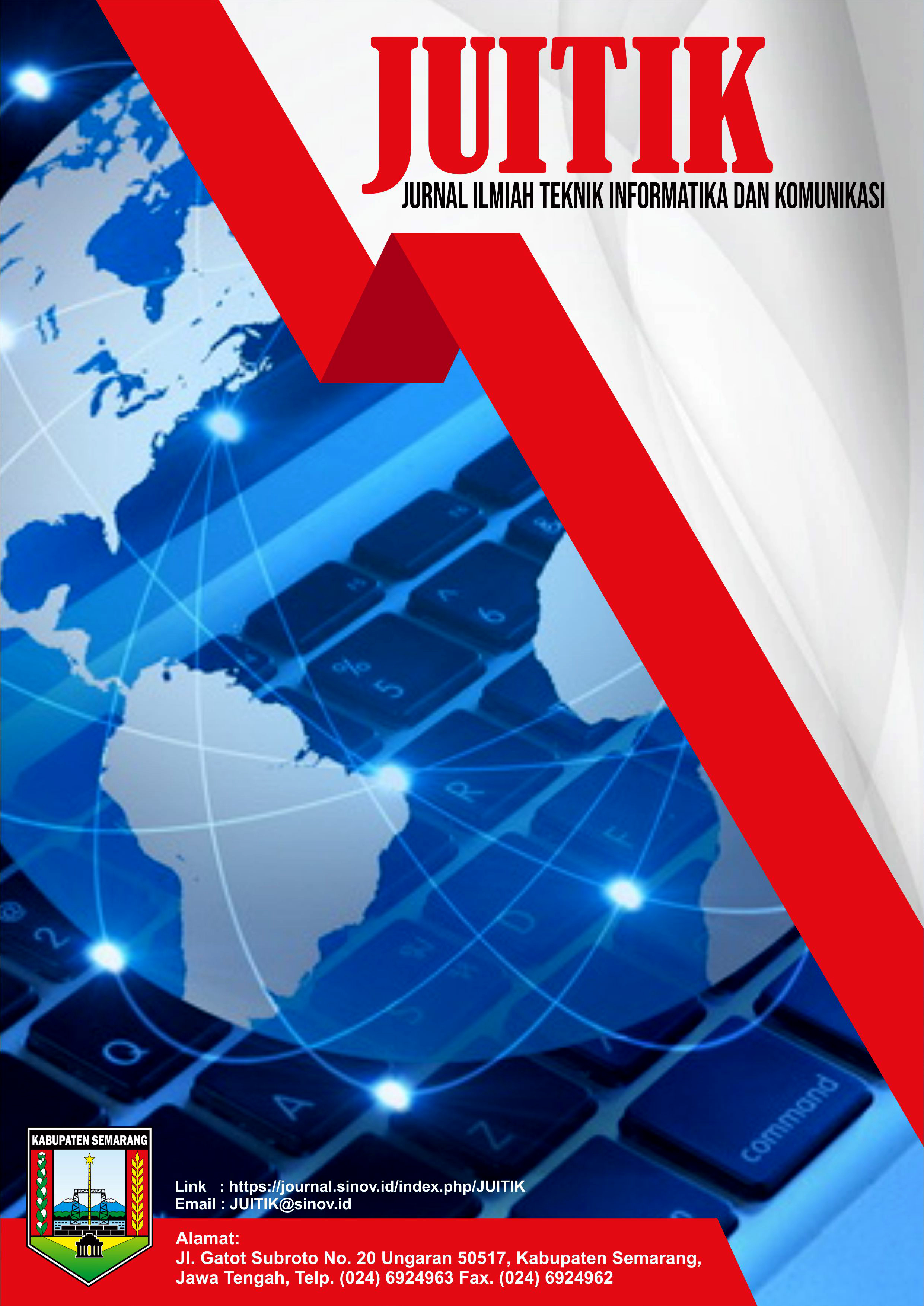Klasifikasi Pola Konsumsi Energi Listrik Rumah Tangga Menggunakan Metode K-Nearest Neighbor
DOI:
https://doi.org/10.55606/juitik.v5i3.1676Keywords:
Classification, Electricity Consumption, Household, K-Nearest Neighbor, Kupang CityAbstract
The increasing demand for electrical energy in Kupang City, particularly in the Kayu Putih Subdistrict, necessitates a system capable of efficiently and accurately identifying electricity consumption patterns. The continuously rising demand for electrical energy may lead to various problems if not properly managed, such as supply disruptions or energy wastage. Therefore, this study aims to classify household electricity consumption patterns using a data-driven approach based on the K-Nearest Neighbor (KNN) method. The KNN method was chosen for its effectiveness in classifying data with a high level of accuracy, especially for datasets with complex characteristics. The designed system categorizes household electricity consumption into three main classes: low, medium, and high. This classification considers several important factors, including the number of family members, the types of electrical appliances used, and their daily usage habits. The results of the study indicate that the KNN method successfully classified household electricity consumption patterns with good performance. Testing using a confusion matrix achieved the highest accuracy of 97% at K = 4. This model was selected for implementation in the household electricity consumption classification system using the K-Nearest Neighbor (KNN) method.
References
Budi, T. S. (2023). Penggunaan AI untuk optimasi penggunaan energi listrik di rumah tangga. Jurnal Repo Teknologi, 3(2). https://repoteknologi.id/index.php/repoteknologi/article/view/372?utm_sourc.com
Caswadi, C., Dienwati, N., Dwilestari, G., Fathurrohman, F., & Tohidi, E. (2023). Penerapan algoritma Naïve Bayes dan K-Nearest Neighbor untuk analisis sentimen YouTube mengenai intensif mobil listrik. JATI (Jurnal Mahasiswa Teknik Informatika), 7(6), 3851–3857. https://doi.org/10.36040/jati.v7i6.8252
Febrianez, C., Saputra, R. E., & Setianingsih, C. (2021). Sistem pembatasan penggunaan energi listrik dengan metode K-Nearest Neighbor berbasis web. eProceedings of Engineering, 8(6). https://openlibrarypublications.telkomuniversity.ac.id/index.php/engineering/article/view/17219
Hafid, H. (2023). Penerapan K-Fold cross validation untuk menganalisis kinerja algoritma K-Nearest Neighbor pada data kasus Covid-19 di Indonesia. Journal of Mathematics, Computations and Statistics, 6(2), 161–168. file:///C:/Users/ACER/Downloads/JMATHCOS62161168.pdf
Hutahaean, Y. M., & Wijayanto, A. W. (2022). Klasifikasi rumah tangga penerima subsidi listrik di Provinsi Gorontalo tahun 2019 dengan metode K-Nearest Neighbor dan Support Vector Machine. JUSTIN (Jurnal Sistem dan Teknologi Informasi), 10(1), 63–68. https://doi.org/10.26418/justin.v10i1.51210
Isnain, A. R., Supriyanto, J., & Kharisma, M. P. (2021). Implementation of K-Nearest Neighbor (K-NN) algorithm for public sentiment analysis of online learning. IJCCS (Indonesian Journal of Computing and Cybernetics Systems), 15(2), 169–178. https://doi.org/10.22146/ijccs.65176
Putri, V. A. P., Prasetijo, A. B., & Eridani, D. (2022). Perbandingan kinerja algoritme Naïve Bayes dan K-Nearest Neighbor (KNN) untuk prediksi harga rumah. Transmisi: Jurnal Ilmiah Teknik Elektro, 24(4), 162–171. https://ejournal.undip.ac.id/index.php/transmisi/article/download/47129/pdf?.com
Rajagukguk, S. A. (2021). Tinjauan pustaka sistematis: Prediksi prestasi belajar peserta didik dengan algoritma pembelajaran mesin. Jurnal Sains, Nalar, dan Aplikasi Teknologi Informasi, 1(1), 22–32. https://doi.org/10.20885/snati.v1i1.4
Salma, S., Dewanta, F., & Abdillah, M. (2022). Klasifikasi beban listrik dengan machine learning menggunakan metode K-Nearest Neighbor. RESISTOR (Elektronika Kendali Telekomunikasi Tenaga Listrik Komputer), 5(2), 163–172. https://doi.org/10.24853/resistor.5.2.163-172
Sarimole, F. M., Pasaribu, F. B., Akbar, Y., & Hidayat, A. Z. (2024). Penerapan algoritma K-Nearest Neighbor untuk klasifikasi status gizi balita di Posyandu Nusa Indah 4. TEKNIKA, 18(2), 489–â. https://doi.org/10.5281/zenodo.12703925
Sidik, A. D. W. M., Kusumah, I. H., Suryana, A., Artiyasa, M., & Junfithrana, A. P. (2020). Gambaran umum metode klasifikasi data mining. FIDELITY: Jurnal Teknik Elektro, 2(2), 34–38. https://doi.org/10.52005/fidelity.v2i2.111
Suhendro, D., & Salis, R. (2024). Prediksi pelanggan listrik menurut jenis pelanggan pada PT. PLN (Persero) UP3 Pematang Siantar menggunakan metode backpropagation. Jurnal Ilmiah Teknik Elektro Terapan, 12(1), 1–10. https://doi.org/10.23960/jitet.v12i3S1.5173
Syafrizal, S., Afdal, M., & Novita, R. (2024). Analisis sentimen ulasan aplikasi PLN Mobile menggunakan algoritma Naïve Bayes Classifier dan K-Nearest Neighbor: Sentiment analysis of PLN Mobile application review using Naïve Bayes Classifier and K-Nearest Neighbor algorithm. MALCOM: Indonesian Journal of Machine Learning and Computer Science, 4(1), 10–19. https://doi.org/10.57152/malcom.v4i1.983
Ulum, S., Alifa, R. F., Rizkika, P., & Rozikin, C. (2023). Perbandingan performa algoritma KNN dan SVM dalam klasifikasi kelayakan air minum. Generation Journal, 7(2), 141–146. https://doi.org/10.29407/gj.v7i2.20270
Yola, O. A. (2020). Studi perilaku konsumsi energi listrik di Universitas Andalas (Doctoral dissertation, Universitas Andalas). http://scholar.unand.ac.id/id/eprint/56516
Downloads
Published
How to Cite
Issue
Section
License
Copyright (c) 2025 Jurnal Ilmiah Teknik Informatika dan Komunikasi

This work is licensed under a Creative Commons Attribution-ShareAlike 4.0 International License.













